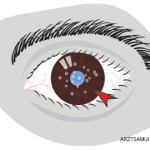NEW YORK (Reuters Health)—Two classes of inflammatory diseases, uveitis and psoriatic disease, appear linked, as a diagnosis of one increases the risk of developing the other, new research has found.
A study of Danish patient registries found nearly triple the rate of uveitis among patients with psoriatic arthritis compared to the general population, and double among patients with severe psoriasis. Likewise, patients with uveitis had a four-fold higher rate of psoriatic arthritis and more than double the rate of severe psoriasis, according to research published online July 29 in JAMA Dermatology.
“Fortunately, the absolute number of patients with psoriasis who develop uveitis, and vice versa, is low. However, increased focus on eye symptoms in patients with psoriasis and on skin and joint symptoms in patients with prior or current uveitis may be appropriate,” lead author Dr. Alexander Egeberg, of Gentofte Hospital at the University of Copenhagen, Denmark, told Reuters Health by email.
The evaluation included about 5.5 million patients over a 15-year period. Among them, Dr. Egeberg and colleagues found 74,129 cases of psoriasis and psoriatic arthritis and 13,114 cases of uveitis.
The researchers found that the patients with uveitis developed severe psoriasis at a rate of 2.66 per 10,000 person-years, compared to 1.12 in the general population. And they developed psoriatic arthritis at a rate of 4.25 per 10,000 person-years, versus 1.04 in the general population.
The link appeared in the other direction, too, as patients with psoriatic arthritis developed uveitis at a rate of 5.49 per 10,000 person-years, compared to 2.02 in the general population. And severe psoriasis patients developed uveitis at a rate of 4.23 per 10,000 person-years.
Poisson regression modeling calculated incidence ratios adjusted for age, sex, socioeconomic status, and comorbidities that included herpes, inflammatory bowel disease and sarcoidosis.
According to the model, uveitis patients have a higher risk of developing severe psoriasis at an adjusted incidence ratio of 2.17 (p<0.001) and of developing psoriatic arthritis at a ratio of 3.77 (p<0.001).
Patients with severe psoriasis have a higher risk of developing uveitis at an adjusted ratio of 1.40. And for patients with psoriatic arthritis, the researchers calculated a ratio of 2.50 (p<0.001).
The link between the inflammatory disorders may stem from the systemic nature of psoriatic disease, Dr. Egeberg said.
“Shared genetic susceptibility and systemic inflammation appear to play a significant role in the relationship between psoriasis and uveitis,” Dr. Egeberg said.
This research was supported by Pfizer, the LEO Foundation, and the Novo Nordisk Foundation. Dr. Egeberg is a Pfizer employee and one coauthor is employed by Eli Lilly and Company.


